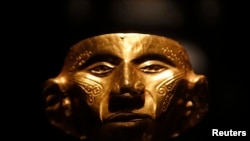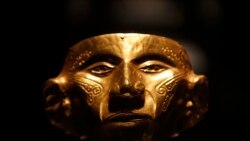With an estimated annual value of 6 to 8 billion dollars, trafficking in stolen cultural property is one of the world’s most profitable criminal ventures, behind trafficking in narcotics and trafficking in arms.
A variety of stolen items from all over the world has been intercepted by U.S. Customs agents, and other specialists who focus on investigations involving cultural property, art, and antiquities. Intercepted items include pre-Columbian pottery, textiles, and human skulls from Latin America; carved relief plaques, sarcophagi, and mummified human remains from ancient tombs all over the world; ancient temple statuary of religious figures from Cambodia; and gold plaques and jewelry from Afghanistan. In one instance, Customs agents intercepted a nearly complete, two-and-a-half meter tall, seven meter long skeleton of a Tyrannosaurus Rex fossil from Mongolia.
The United States as one of the top destinations for smuggled cultural artifacts, works closely with partner countries to intercept these objects and recover those that are on the market or in the possession of an individual, anywhere in the United States.
To facilitate such cooperation, the United States has entered into Bilateral Agreements and Memoranda of Understanding with a number of countries, at their request, whose cultural heritage is vulnerable to archaeological looting and illegal export of items of cultural, religious, and historical value.
In 2004, the United States signed such a Memorandum of Understanding with the Republic of Honduras. As part of the agreement, the United States imposed import restrictions on pre-Columbian artifacts to curtail the pillage and illicit trafficking of Honduras’ rich archaeological heritage.
In 2009, the Memorandum was extended for five years, and again on March 12th of this year. But this time, the Memorandum was also amended to expand the list of designated materials to include certain categories of ecclesiastical materials from Honduras’ colonial period.
This change recognizes that most of the illicitly trafficked antiquities come not only from tens of thousands of archaeological sites, but also from churches throughout the country and it protects the rich ecclesiastical heritage of the Colonial period.
The Memorandum of Understanding highlights the United States’ ongoing commitment to preserve, protect, and respect the heritage of other countries.
A variety of stolen items from all over the world has been intercepted by U.S. Customs agents, and other specialists who focus on investigations involving cultural property, art, and antiquities. Intercepted items include pre-Columbian pottery, textiles, and human skulls from Latin America; carved relief plaques, sarcophagi, and mummified human remains from ancient tombs all over the world; ancient temple statuary of religious figures from Cambodia; and gold plaques and jewelry from Afghanistan. In one instance, Customs agents intercepted a nearly complete, two-and-a-half meter tall, seven meter long skeleton of a Tyrannosaurus Rex fossil from Mongolia.
The United States as one of the top destinations for smuggled cultural artifacts, works closely with partner countries to intercept these objects and recover those that are on the market or in the possession of an individual, anywhere in the United States.
To facilitate such cooperation, the United States has entered into Bilateral Agreements and Memoranda of Understanding with a number of countries, at their request, whose cultural heritage is vulnerable to archaeological looting and illegal export of items of cultural, religious, and historical value.
In 2004, the United States signed such a Memorandum of Understanding with the Republic of Honduras. As part of the agreement, the United States imposed import restrictions on pre-Columbian artifacts to curtail the pillage and illicit trafficking of Honduras’ rich archaeological heritage.
In 2009, the Memorandum was extended for five years, and again on March 12th of this year. But this time, the Memorandum was also amended to expand the list of designated materials to include certain categories of ecclesiastical materials from Honduras’ colonial period.
This change recognizes that most of the illicitly trafficked antiquities come not only from tens of thousands of archaeological sites, but also from churches throughout the country and it protects the rich ecclesiastical heritage of the Colonial period.
The Memorandum of Understanding highlights the United States’ ongoing commitment to preserve, protect, and respect the heritage of other countries.

















